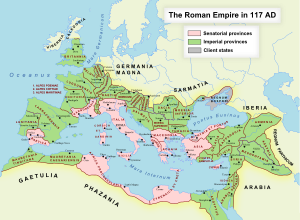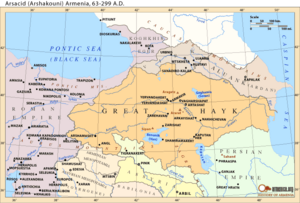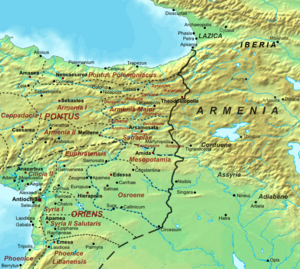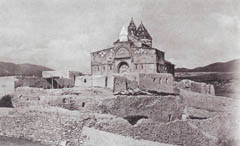Roman Armenia facts for kids
Quick facts for kids Provincia ArmeniaՀռոմեական Հայաստան ἐπαρχία Αρμενίας |
|||||||||
|---|---|---|---|---|---|---|---|---|---|
| Province of the Roman Empire | |||||||||
| 114–118 | |||||||||
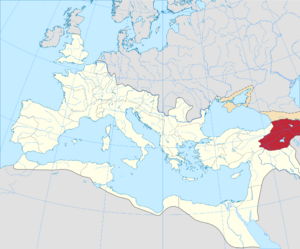 |
|||||||||
| Capital | Artashat | ||||||||
| Historical era | Classical antiquity | ||||||||
|
• Established
|
114 | ||||||||
|
• Disestablished
|
118 | ||||||||
|
|||||||||
| Today part of | |||||||||
Roman Armenia refers to times when parts of Greater Armenia were ruled by the Roman Empire. This happened from the 1st century AD until the end of ancient times. While Armenia Minor became a Roman "client state" (a country controlled by Rome), Greater Armenia stayed an independent kingdom. It was ruled by the Arsacid family.
Armenia was often a disputed area between Rome and the Parthian Empire. Later, it was also fought over by Rome and the Sasanian Empire, which took over from the Parthians. These conflicts led to several Roman–Persian Wars. In 114 AD, Emperor Trajan conquered Armenia and made it a Roman province, but this only lasted a short time.
In the late 4th century, Armenia was split between Rome and the Sasanians. The Sasanians took control of most of the Armenian Kingdom. By the mid-5th century, they ended the Armenian monarchy. In the 6th and 7th centuries, Armenia became a battleground again. This time, it was between the East Roman Empire (also called the Byzantine Empire) and the Sasanian Empire. Both empires were later defeated by the Muslim Caliphate in the mid-7th century.
Contents
A Look at Ancient Armenia
After the Artaxiad dynasty fell in 66 BC, the Kingdom of Armenia was often fought over. The main rivals were the Roman Empire and the Parthian Empire. For most of this time, Armenia was ruled by the Arsacid family. The Armenian noble families, called Nakharar, were often divided. Some supported Rome, some supported Parthia, and some tried to stay neutral.
Armenia often acted as a "client state" or "vassal" (a smaller country controlled by a larger one). It was on the border of these two big empires and their later forms, the Byzantine and Sassanid empires. During the wars between the Byzantines and Sasanians, Armenia was eventually split. This led to Byzantine Armenia and Sasanian Armenia.
Rome and Parthia Fight for Control
As the Roman Republic grew eastward, it reached Armenia. In 66–65 BC, Pompey made the Kingdom of Armenia a Roman client kingdom. For the next 100 years, Rome had a lot of influence over Armenia. But by the mid-1st century AD, the Parthian Empire grew stronger. They challenged Rome's power. Rome regained control after the campaigns led by Gnaeus Domitius Corbulo.
This conflict ended with the Battle of Rhandeia. It was like a tie, and they made a deal. A Parthian prince from the Arsacid family would become the king of Armenia. But the Roman emperor had to approve his appointment.
Armenia Becomes a Roman Province (114–118 AD)
In 114 AD, Emperor Trajan made Armenia a full Roman province. He wanted to bring this "vassal state" fully into the Roman Empire. Trajan marched from Antioch in Syria and conquered the Armenian capital, Artaxata. He removed the Armenian king, Parthamasiris, and declared Armenia a new Roman province.
This new province reached the Caspian Sea. To the north, it bordered Caucasian Iberia and Albania, which were Roman vassal states. As a Roman province, Armenia was managed along with Cappadocia.
The Roman Senate even made coins to celebrate this. They had the words "ARMENIA ET MESOPOTAMIA IN POTESTATEM P.R. REDACTAE" on them. This meant "Armenia and Mesopotamia brought under the power of the Roman people." A rebellion by a Parthian leader named Sanatruces was stopped. However, some resistance continued until Trajan died in August 117 AD.
Armenia as a Roman Protectorate
After Trajan died, his successor Hadrian decided not to keep Armenia as a Roman province. In 118 AD, Hadrian gave Armenia back its independence. He made Parthamaspates its king. But Parthamaspates was soon defeated by the Parthians. He fled back to the Romans, who gave him control of Osroene in western Greater Armenia.

Sohaemus was made king of Armenia by Roman emperor Antoninus Pius in 140 AD. But just a few years later, in 161 AD, Armenia was lost again to Vologases IV of Parthia. In 163 AD, a Roman attack led by Statius Priscus defeated the Parthians in Armenia. Sohaemus was put back on the Armenian throne as Rome's chosen king.
Armenia was often a point of disagreement between the two empires. They each tried to put their own chosen kings on the Armenian throne. This continued until the Sasanians became a new powerful empire. Rome's power grew over the years, but Armenia kept its independence. It was a Roman ally against the Sasanian Empire. Many Armenian soldiers fought in the Roman army. Later, in the 4th century, there were two Roman legions made up of Armenian soldiers. These were the Legio I Armeniaca and the Legio II Armeniaca.
In the late 3rd century, the Roman Emperor Carus attacked the Sassanid capital, Ctesiphon, and parts of southern Armenia. By 299 AD, all of Armenia became a Roman "vassal territory" again. This happened after Diocletian's victory over the Sasanians.
Eastern Roman Armenia
In 363 AD, a treaty was signed between the East Roman (Byzantine) and Sassanid Persian empires. This treaty divided Armenia between them. The Persians kept the larger part of Armenia, called "Persarmenia." The Romans received a small part of Western Armenia.
Another treaty, the Peace of Acilisene, followed around 387 AD. This set a clear border. The area under East Roman control grew, but about four-fifths of the old Kingdom of Armenia stayed under Persian rule.
Unlike Armenia Minor (west of the Euphrates River), which had become full Roman provinces earlier, the new territories kept some freedom. Armenia Maior, the northern half, had its own local government. It had to pay taxes and provide soldiers to the Roman army.
Under Roman rule, Melitene was an important base for the Roman army. Emperor Theodosius I divided this region into two provinces. These were First Armenia and Second Armenia.
The southern areas, called "satrapies," were different. They were six independent areas allied with the Roman Empire. The local Armenian nobles, called nakharar, ruled their lands. They only had to provide soldiers when asked and send a golden crown to the emperor. In return, they received their royal symbols from the emperor.
This situation lasted for almost a century. But in 485 AD, the satraps rebelled against Emperor Zeno. After this, the satraps lost their independence. They became like regular tax-paying Roman areas.
Emperor Justinian I (who ruled from 527–565 AD) made many changes to the government. In 536 AD, new changes ended the freedom of the areas beyond the Euphrates. Four new regular provinces were formed. In 538 AD, Armenian nobles rebelled against high taxes. They were defeated and had to flee to Persia.
In 591 AD, a treaty between Khosrow II and Maurice gave most of Persarmenia to the Eastern Roman Empire.
Later History
The region became a major battleground in the Byzantine–Sasanian War of 602–628. After the start of the Muslim conquests and the Arab conquest of Armenia, only the western parts of Armenia remained under Byzantine control.
Armenia was then mostly ruled by Arabs. Later, as the Caliphate's power weakened, the Byzantines regained influence over Armenian areas. This happened during the campaigns of John Kourkouas in the early 10th century. In the early 11th century, most of Armenia came under direct Byzantine control. This lasted until the Battle of Manzikert in 1071 AD. After this battle, all of Armenia fell to the Seljuks.
Christianity in Armenia
Christianity began to spread in Armenia in the 1st century AD. It was first brought by the apostles Bartholomew and Jude Thaddeus. These two Saints are considered the special protectors of the Armenian Apostolic Church.
It is believed that Apostle Bartholomew was killed in Albanopolis in Armenia. He was supposedly martyred for converting the king of Armenia, Polymius, to Christianity. However, there are no records of an Armenian king named Polymius from that time. Some experts now think Bartholomew might have died in India.
Armenia became the first country to make Christianity its official religion. This happened around 301 AD. Gregory the Illuminator convinced Tiridates III, the king of Armenia, to convert to Christianity.
After Rome's victory over the Sasanians in 299 AD, Armenia became a Roman vassal state again. This helped Christianity spread widely in the region. It led to the full Christianization of Armenia.
Before this, the main religion in Armenia was Zoroastrianism, which was supported by the Parthian and Sassanid Empires. There was also some local Paganism. Saint Gregory and his son Aristaces helped convert all Armenians in the first half of the 4th century. This happened especially after Roman emperor Constantine made Christianity legal in the Roman Empire in 313 AD.
It is a well-known fact that Armenians were the first nation to officially become Christian. After this, in the 4th and 5th centuries, Christianity became a strong part of Armenian culture and government. Gregory the Illuminator organized the Armenian Church. Since then, the leaders of the Armenian Church have been called Catholicos, and they still use this title today.
Saint Gregory chose the capital city of Vagharshapat (now Ejmiatsin) as the center of the Church. He built the Etchmiadzin Cathedral there around 301-303 AD.
Because of constant political changes in Armenia, the Church center sometimes moved to safer places. These places were often connected to the Eastern Roman Empire. The Church center eventually moved to Byzantine Cilicia in the 13th century.
See also
- Legio I Armeniaca
- Legio II Armeniaca
- Sasanian Armenia
- Lesser Armenia
- Kingdom of Armenia (antiquity)
- Mamikonian
- Roman Georgia
- Byzantine Armenia
- Caucasian Albania


